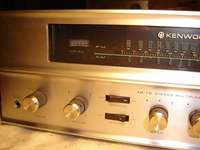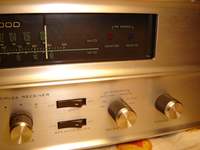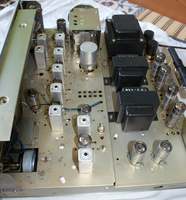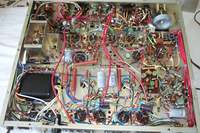-

kenwood kw-44

 

 |
Kenwood's
KW-44 model was the successor to the KW-30 model. The
basic change was in a more modern design. The previous
one, in pastel colors and with a tin "two-level" front
panel and plastic knobs (the same design is featured on
the other side of the KW-70), was replaced by an aluminum
milled front plate and Bakelite knobs with metal caps. The
amplifier of the receiver worked in a Push & Pull
configuration using 6BM8 / ECL82 tubes in an automatic
bias system. The output power was approx. 2 x 10 W. It was
intended for loudspeakers with a resistance of 8 and 16
ohms. The receiver could work with external signal
sources, such as a turntable with a magnetoelectric
cartridge. The RIAA correction preamplifier was a standard
and quite good design from Kenwood on the two 12AX7 /
ECC83. Apart from turntables, the AUX signal and a tape
recorder could be connected to the receiver. The KW-44 had
a total of 16 lamps on board. Although this model was a
cheap, "budget" version, it worked very well. The FM head
worked on two 6AQ8 / ECC85, but one section was
responsible for the AFC. Behind the head there was a
three-stage amplifier. and a well-working MPX decoder on
two 6AU6 / EF94 and 6BL8 / ECF80 tubes. The receiver did
not have a stereo indicator. On the front, there were
colored "eyes" illuminated when tuning to a stereo signal.
It consisted in switching to the "FM Stereo / Monitor"
position (the appropriate light on the scale was then lit)
and searched for a stereo station. When receiving stations
with MPX signal, the "screeching" sound disappeared and it
was necessary to switch to the "FM Stereo / Receive"
position. This resulted in a change in the illumination of
the bulb on the front. Complicated ? Very much, but
Kenwood used this arrangement very often. Min. Lafayette
LR-800 had a very similar layout. The budget solution was
also the volume and balance control on one double
independent potentiometer. The outer knob regulated the
left channel, and the inner one, the one closer to the
front, the right. The bandwidth control also had
potentiometers with adjustable separate sections. The
receiver had a loudspeaker switch on the front (which was
important when listening on headphones), an MPX filter -
because then the MPX signal often disturbed the audio path
and Loudness switch to boost the sound physiologically.

 
|
Main page
Previous page
Contact
|